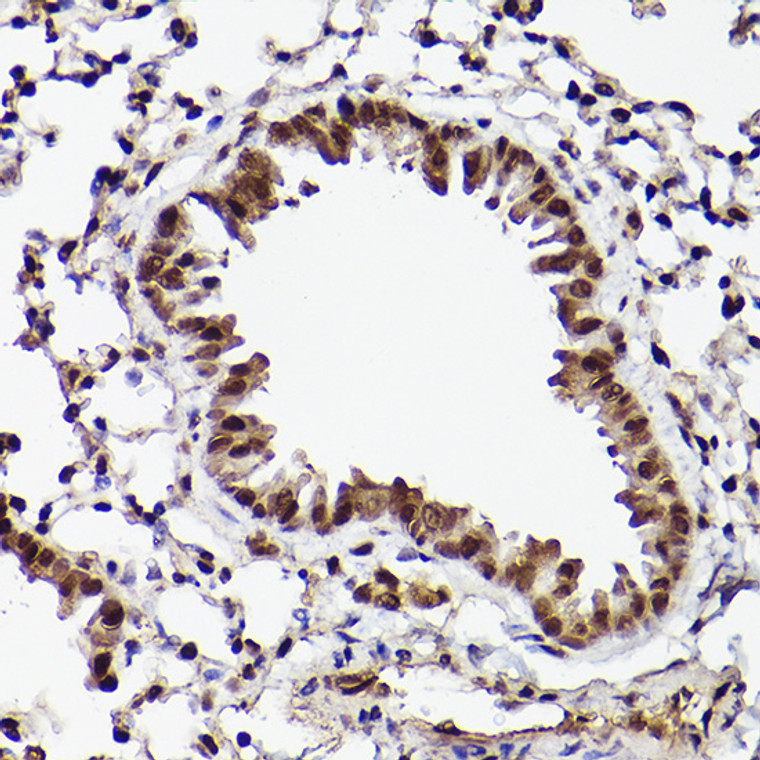| Host: |
Rabbit |
| Applications: |
WB/IHC/IF |
| Reactivity: |
Human/Mouse/Rat |
| Note: |
STRICTLY FOR FURTHER SCIENTIFIC RESEARCH USE ONLY (RUO). MUST NOT TO BE USED IN DIAGNOSTIC OR THERAPEUTIC APPLICATIONS. |
| Short Description: |
Rabbit polyclonal antibody anti-ATF5 (101-282) is suitable for use in Western Blot, Immunohistochemistry and Immunofluorescence research applications. |
| Clonality: |
Polyclonal |
| Conjugation: |
Unconjugated |
| Isotype: |
IgG |
| Formulation: |
PBS with 0.01% Thimerosal, 50% Glycerol, pH7.3. |
| Purification: |
Affinity purification |
| Dilution Range: |
WB 1:500-1:2000IHC-P 1:50-1:200IF/ICC 1:50-1:200 |
| Storage Instruction: |
Store at-20°C for up to 1 year from the date of receipt, and avoid repeat freeze-thaw cycles. |
| Gene Symbol: |
ATF5 |
| Gene ID: |
22809 |
| Uniprot ID: |
ATF5_HUMAN |
| Immunogen Region: |
101-282 |
| Immunogen: |
Recombinant fusion protein containing a sequence corresponding to amino acids 101-282 of human ATF5 (NP_036200.2). |
| Immunogen Sequence: |
MASLLKKELEQMEDFFLDAP PLPPPSPPPLPPPPLPPAPS LPLSLPSFDLPQPPVLDTLD LLAIYCRNEAGQEEVGMPPL PPPQQPPPPSPPQPSRLAPY PHPATTRGDRKQKKRDQNKS AALRYRQRKRAEGEALEGEC QGLEARNRELKERAESVERE IQYVKDLLIEVYKARSQRTR SC |
| Tissue Specificity | Widely expressed with higher expression levels in liver. |
| Post Translational Modifications | Ubiquitinated by CDC34 and UBE2B in order to be degraded by the proteasome. Cisplatin inhibits ubiquitination and proteasome-mediated degradation by inhibiting the interaction with CDC34. Ubiquitination and degradation by the proteasome are inhibited by NLK in a kinase-independent manner. Phosphorylated by NLK, probably at Ser-92, Thr-94, Ser-126 and Ser-190. Acetylated at Lys-29 by EP300, the acetylation enhances the interaction with CEBPB, DNA-binding and transactivation activity. |
| Function | Transcription factor that either stimulates or represses gene transcription through binding of different DNA regulatory elements such as cAMP response element (CRE) (consensus: 5'-GTGACGTACAG-3'), ATF5-specific response element (ARE) (consensus: 5'-CCTTCTCTCCTTAT-3') but also the amino acid response element (AARE), present in many viral and cellular promoters. Critically involved, often in a cell type-dependent manner, in cell survival, proliferation, and differentiation. Its transcriptional activity is enhanced by CCND3 and slightly inhibited by CDK4. Important regulator of the cerebral cortex formation, functions in cerebral cortical neuroprogenitor cells to maintain proliferation and to block differentiation into neurons. Must be down-regulated in order for such cells to exit the cycle and differentiate. Participates in the pathways by which SHH promotes cerebellar granule neuron progenitor cells proliferation. Critical for survival of mature olfactory sensory neurons (OSN), directs expression of OSN-specific genes. May be involved in osteogenic differentiation. Promotes cell proliferation and survival by inducing the expression of EGR1 sinergistically with ELK1. Once acetylated by EP300, binds to ARE sequences on target genes promoters, such as BCL2 and EGR1. Plays an anti-apoptotic role through the transcriptional regulation of BCL2, this function seems to be cell type-dependent. Cooperates with NR1I3/CAR in the transcriptional activation of CYP2B6 in liver. In hepatic cells, represses CRE-dependent transcription and inhibits proliferation by blocking at G2/M phase. May act as a negative regulator of IL1B transduction pathway in liver. Upon IL1B stimulus, cooperates with NLK to activate the transactivation activity of C/EBP subfamily members. Besides its function of transcription factor, acts as a cofactor of CEBPB to activate CEBPA and promote adipocyte differentiation. Regulates centrosome dynamics in a cell-cycle- and centriole-age-dependent manner. Forms 9-foci symmetrical ring scaffold around the mother centriole to control centrosome function and the interaction between centrioles and pericentriolar material. |
| Protein Name | Cyclic Amp-Dependent Transcription Factor Atf-5Camp-Dependent Transcription Factor Atf-5Activating Transcription Factor 5Transcription Factor Atfx |
| Database Links | Reactome: R-HSA-9648895 |
| Cellular Localisation | CytoplasmNucleusCytoskeletonMicrotubule Organizing CenterCentrosomeActively Transported To The Centrosome And Accumulated In The Pericentriolar Material (Pcm) During G1 To M Phase Via A Microtubule-Dependent MechanismDuring Late Telophase And CytokinesisTranslocates From The Centrosome To The Midbody |
| Alternative Antibody Names | Anti-Cyclic Amp-Dependent Transcription Factor Atf-5 antibodyAnti-Camp-Dependent Transcription Factor Atf-5 antibodyAnti-Activating Transcription Factor 5 antibodyAnti-Transcription Factor Atfx antibodyAnti-ATF5 antibodyAnti-ATFX antibody |
Information sourced from Uniprot.org
12 months for antibodies. 6 months for ELISA Kits. Please see website T&Cs for further guidance











